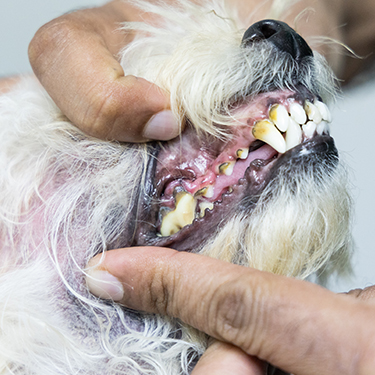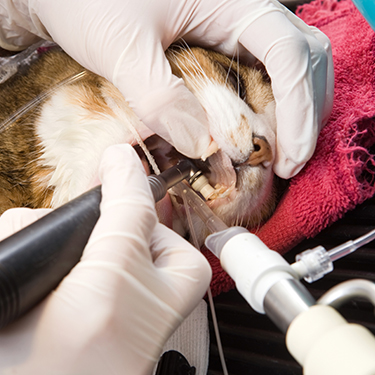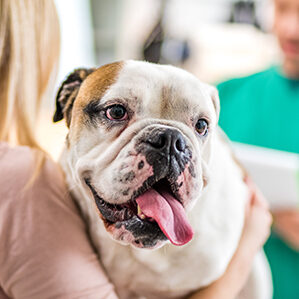Signs Your Pet is Ready to Have Their Teeth Cleaned
While our pets do not have the ability to say how they’re feeling or what’s wrong, we can check for certain signs to help give voice to their problems.
Here are some of the most common warning signs of poor oral health in dogs and cats:
- Bad breath
- Teeth are discolored and/or covered in yellow/brown residue
- Gums are swollen and reddened
- Drooling
- Dropping food while eating
- Chewing on one side
- Avoiding chew toys
- Shy about having their mouth touched
- Sleeping more, eating less, and other behavior changes


What is Included in a Dog or Cat Dental Cleaning?
When performing a COHAT, or Comprehensive Oral Health Assessment and Treatment, our goal is to thoroughly evaluate your pet’s oral health.
Dental prophylaxes include preanesthetic blood work, removing all traces of plaque and calculus, polishing the enamel, and tooth extractions if necessary.
We recently upgraded to state-of-the-art dental, radiography, and anesthesia machines that allow us to perform complex dental procedures more safely and, in less time, thereby reducing anesthetic risks. These updates combined with safer inhalant anesthetics and anesthesia monitoring devices allow us to minimize anesthetic risks while providing more comprehensive care.
An oral exam.
First, we need to see your pet for an oral examination so we can determine whether a cleaning is warranted. We will look for the telltale signs of dental disease, including reddened gums and buildup on the teeth.
General anesthesia.
To safely and thoroughly examine and clean your pet’s teeth, we will need to place them under general anesthesia. We will assess your pet’s health beforehand to make sure anesthesia risks are minimal. Additionally, having your pet under anesthesia makes it easier for us to conduct a more detailed exam of their teeth and gums.
Teeth cleaning and polishing.
Our team uses various advanced cat and dog teeth cleaning tools to remove all traces of plaque and calculus from each tooth, both below and above the gum line. We also polish the tooth enamel smooth to prevent plaque from sticking to the teeth.
Tooth extractions (if needed).
If necessary, we can also perform a tooth extraction (or extractions) if your pet has any teeth that are too loose or damaged to save. We provide adequate pain relief medication during and after the procedure to relieve discomfort as much as possible.
What is included in a COHAT?
COHAT is hard to define in exact terms, because it is so customizable. Every patient is unique, so each COHAT is different. There are some essential elements of COHAT that are used in every patient.
Every COHAT will include:
- A review of pre-anesthesia blood work
- An assessment of the pet’s medical records with attention medical history, physical exams, and dietary and chewing habits
- A thorough oral exam
- Dental probing and charting
- Full mouth dental X-ray
- Discharge instructions including pain control and feeding instructions
- Recheck exam and / or a plan for a future COHAT

Reasons to Start Brushing Your Pet’s Teeth
Cat and dog teeth cleanings at our hospital are important in the fight against dental disease, but they are only one part of the bigger picture. Even more important is the care you provide to your pet at home on a daily basis. Routine teeth brushing decreases plaque buildup significantly and helps dogs and cats go longer between teeth cleanings at our Oklahoma City practice.
We also carry OraVet Dental Hygiene Chews to reduce and help prevent plaque formation.
In addition to brushing, you can supplement your pet’s diet and try other dental care alternatives to improve their oral hygiene. For tips and recommendations, call (405) 842-2273!
Ask us about at home dental care!

